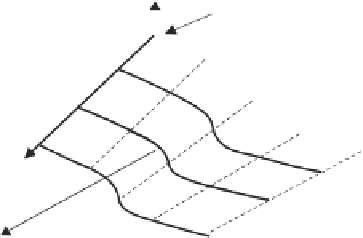Environmental Engineering Reference
In-Depth Information
After
stress
path 1
Initially slurry
Water content,
w
Initial
yield
surface
After
stress
path 2
1:1
2
1
10
6
10
6
log(
ψ
)
p
0
Soil
suction (kPa)
Soil suction,
ψ
Net mean
stress (kPa)
(kPa)
log(
p
)
(a)
1:1
Initially slurry
1:1
Void ratio,
e
1:1
0
Net mean stress,
p
(kPa)
Figure 13.41
Evolution of yield surface (from Pham, 2002).
The yield stress can be described as a surface represent-
ing yield stresses of pores along the pore-size distribution
(Fig. 13.41). Equations for the change in the air-entry value
of a pore for collapsible and noncollapsible pores can be
obtained by modifying Eq. 13.104 as follows:
log(
ψ
)
p
0
Soil
suction (kPa)
Net mean
stress (kPa)
ψ
aev
ψ
aev
(p, p
y
)
log (
p
)
(b)
(C
c
−
C
s
)
log
(p
y
)
+
C
s
log
(ψ
aev
+
p)
−
C
c
log
(ψ
aev
)
3[
e
sat
−
C
c
log
(ψ
aev
)
−
Figure 13.42
Volume-mass constitutive surfaces obtained from
loading-unloading processes of an initially slurry specimen dried
under various constant net mean stresses: (a) water content consti-
tutive surface; (b) void ratio constitutive surface.
=
1
−
η
w
r
G
s
]
(13.127)
Similarly, an equation for the change in the water-entry
value of a pore can be obtained by modifying Eq. 13.105 as
follows:
volumes in the soil that have soil suction values higher than
the selected suction value. The overall volume of the rep-
resentative soil element can be calculated as a summation
from zero suction to a suction value of 10
6
kPa.
The volume-mass constitutive surfaces have been exper-
imentally shown to be stress path dependent (Alonso,
1993; Pham, 2005). Each volume-mass constitutive surface
pertains to a particular testing stress path and an equation
is required to describe that surface. It is possible, however,
to derive closed-form equations for the volume-mass
constitutive surfaces (i.e., both overall volume and water
content) corresponding to any particular stress paths.
Two equations can be used to describe the volume-mass
constitutive surfaces for simple stress paths (Fig. 13.42).
The stress paths commence with a soil at slurry conditions
that are loaded to a net mean stress of
p
0
at zero suction and
then dried under various constant net mean stresses. The
soil parameter
m
is not required for this stress path since
there is no change in net mean stress after pores are filled
with air.
ψ
wev
ψ
wev
(p, p
y
)
(C
c
−
C
s
)
log
(p
y
)
+
C
s
log
(ψ
wev
+
p)
−
C
c
log
(ψ
aev
)
3[
e
sat
−
C
c
log
(ψ
aev
)
−
=
1
−
η
w
r
G
s
]
(13.128)
If soil suction is less than the water-entry value of the pore
along a wetting path, then the pore is filled with water; other-
wise, it is filled with air. If suction is less than the air-entry
value along a drying process, then the pore is filled with
water; otherwise, it is filled with air. The air-entry value and
water-entry value of a pore are calculated using Eqs. 13.127
and 13.128, respectively.
The pore-size distribution of the soil corresponding to a
particular stress state can be calculated. The volume of water
in a representative soil element at a designated suction
ψ
is calculated as a summation (i.e., integration) of all pore









































Search WWH ::

Custom Search